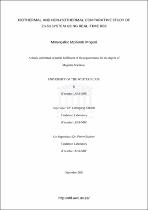| dc.contributor.advisor | Kotsedi, Lebogang | |
| dc.contributor.author | Mnguni, Mmangaliso Mpilonde | |
| dc.date.accessioned | 2022-03-30T08:10:14Z | |
| dc.date.available | 2022-03-30T08:10:14Z | |
| dc.date.issued | 2021 | |
| dc.identifier.uri | http://hdl.handle.net/11394/8996 | |
| dc.description | >Magister Scientiae - MSc | en_US |
| dc.description.abstract | Insight into the effects of isothermal and non-isothermal annealing on bi-metallic thin film is
important for material synthesis and application in everyday use. The effects of isothermal
annealing on bi-metallic thin films has long been studied using various heating methods from
a resistively heated filaments, by transferring heat via conduction, convection and irradiation.
The effect of each method have been widely reported in literature. The diffusion coefficient
and activation energies of the constituent atoms can calculated for each annealing method.
On the other hand, the effects of non-isothermal annealing on bi-metallic thin films has not
been comprehensively studied, and there are areas of this annealing regime that need further
investigation. In this study a femtosecond laser with a 1064 nm central wavelength was used
to anneal bi-metallic thin films of Zinc-Tin (Zn-Sn) on a substrate. | en_US |
| dc.language.iso | en | en_US |
| dc.publisher | University of the Western Cape | en_US |
| dc.subject | Atomic force microscopy | en_US |
| dc.subject | Diffusion | en_US |
| dc.subject | Solid phase reaction | en_US |
| dc.subject | X-ray diffraction | en_US |
| dc.subject | Zinc | en_US |
| dc.title | Isothermal and non-isothermal comparative study of zn-sn system using real-time rbs | en_US |
| dc.rights.holder | University of the Western Cape | en_US |

